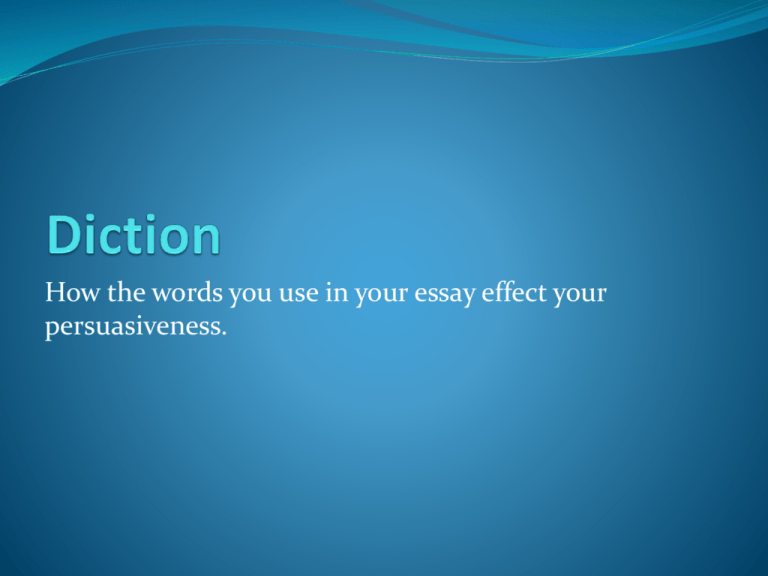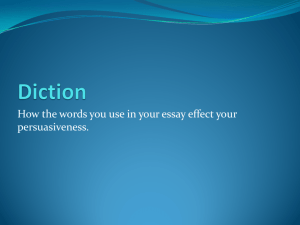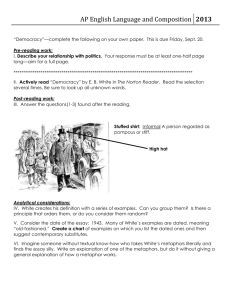Diction of your persuasive essay
advertisement

How the words you use in your essay effect your persuasiveness. Vocabulary of Issue The discourse of your topic Use discourse of issue but remember to define key terms if needed: subprime mortgage, underwater, CFO’s vs. factory farms Spell out abbreviations first time and include abbreviation immediately after, and thereafter use just the abbreviation National Association for the Advancement of Colored People (NAACP) National Public Radio (NPR) What are some key terms in the discourse of your topic? Write them down so you will remember Tone Tone : should be educated , formal, and reasonable—beyond that it’s up to you (serious, urgent, thoughtful, welcoming, angry, etc.) Formality means: avoiding contractions and most abbreviations (don’t write TV, write television); longer, more complex sentences; favoring the objective third person (Americans, consumers, etc.) over second person (you) Avoid insulting your audience Of course, . . . It’s obvious that. . . . Everybody knows/agrees that… Use qualified language Avoid overgeneralizing and using words like all, everyone, Americans, always Instead use words like some, many Americans, and often Tone and Organization 1. Avoid questioning the reader, because… It creates an informal relationship You should be the authority persuading the reader what to think, not just provoking the reader to think Example: Haven’t you seen a lot of large people around town? Don’t you think obesity is a problem? Instead state it: One can simply look around to see that many people in our lives are obese. 2. Also, avoid using questions to transition. Questioning the reader does not create a smooth sentence to sentence transition as student writers often seem to think it does Obesity is a severe problem in the United States. Looking around, you might ask yourself, why is this such a big issue? Obesity is an issue because… Tone and Organization Often, student writers think they are asking a question with one obvious answer, but they are wrong. Example: Research question: Should national education standards be applied to K-12 education? Excerpt from student argumentative essay: “National standards are not raising the bars for student education but instead in order to stay competitive with other nations. The United States is trying to have their students’ educational level rise and be above all others. If this is the way of thinking when trying to place standards, then how can these standards possibly benefit students?” This author assumes that what benefits the U.S. cannot also benefit students. This is an illogical assumption. Denotation/Connotation The words you use reflect your stance, and that’s a good thing, but be careful about using words without paying attention to their connotations Denotation: dictionary definition; literal meaning Connotation: all the emotions and associations that come with a word The Economic Bailout Package compared to The Rescue Package compared to The Consumer Protection Act Obama Healthcare Reform versus Obamacare Explore the differences Hard vs. challenging Plain vs. natural Frugal vs. cheap Cultured vs. snobby Cop vs. police officer The discourse of argument Key words and phrases that are often useful in writing arguments The issue started to take shape when _______________ Words for those in support of something: Proponents, advocates, supporters, stakeholders, backers, sponsors, allies, defenders, champions Words for those against something: Critics, naysayers, protestors, dissenters Avoid the basic and awkward Those who are pro X….Those who are con X When introducing reasons and evidence One supporting point of ________ is ___________. Proponents of ______________ argue that _______________. Evidence that supports this idea is______________. _______________ suggests that _______________. Key verbs See pg. 420 in Little, Brown Handbook for useful verbs, such as notes, argues, implies, reasons, acknowledges, grants Avoid basic verbs, such as says Figurative Language In contrast to literal language, in which what is written is EXACTLY what one means, figurative language is whenever the writer uses language metaphorically, or NOT exactly Some quick examples of literal language: http://theoatmeal.com/comics/literally Some kinds of figurative language are analogies, metaphors, similes, and personification Student writers use figurative language (in relevant places) to enhance their persuasiveness--and get better diction scores! Practice: Should you use literally or figuratively? (a) Some students are getting swept out of the library, _____ speaking. (b) The word photography _____ means "drawing with light." Figurative Language: Analogies are. . . An elongated comparison for the purposes of illustration or drawing parallels This comparison may even extend through a whole essay or speech Example: "I look at this as being in the form of a house...and the students are the foundation, and the teachers are the walls, and the roof itself is the school. And we know that if you have a weak foundation, the walls and the roof can't be supported. Therefore, it crumbles." Northwestern State University student Jason Madison, Student's should 'come first' address More analogy examples. . . "Wishing for the end to AIDS and extreme poverty in Africa is like wishing that gravity didn't make things so damn heavy. We can wish it, but what the hell can we do about it?" Bono, 2004 Commencement Address at The University of Pennsylvania Metaphors are. . . A comparison between two things, based on resemblance or similarity, without using “like” or “as.” A device for seeing something in terms of something else The act of giving a thing a name that belongs to something else. Some examples of metaphors: The teacher descended upon the exams, sank his talons into their pages, ripped the answers to shreds, and then, perching in his chair, began to digest. What two things are being compared here? Teacher grading to a bird eating its prey That school is a jungle and the students the wild animals within. What two things are being compared here? The school to a jungle The young women were cool and confident lionesses, checking out their prey at the club. The young women to lions on the prowl Similes Similes are comparisons that use “like” or “as”: Her face was pale as the moon. What two things are being compared here? The paleness of her face to the whiteness of the moon My feet felt like concrete blocks after a hard day of waitressing. What two things are being compared here? The difficulty of lifting her feet to lifting concrete blocks Other kinds of figurative language Personification: giving human qualities to animals or objects; giving lifelike qualities to nonliving things. The thunder growled to be let in. What lifelike quality is being given and to what nonhuman thing? Growling is being attributed to thunder The house’s windows were glowing eyes in the stormy night. What lifelike quality is being given and to what nonhuman thing? Glowing eyes are being attributed to lighted windows The book begged to be read. What lifelike quality is being given and to what nonhuman thing? Begging is being attributed to a book. Why use metaphors? They enliven ordinary language. They are generous to readers and listeners; they encourage interpretation. They are more efficient and economical than ordinary language; they give maximum meaning with a minimum of words. They create new meanings; they allow you to write about feelings, thoughts, experiences, etc. for which there are no easy words; they are necessary. They are a sign of genius. Metaphors convey experience in a way ordinary words cannot Life is a. . . rollercoaster, garden, prison, winding journey, full-time job, rat race, jungle, circus Now you try: Love is like. . . An animal Love is like a wild tiger. It may be beautiful, but it’s also uncontrollable. A place Love is like Disney World. It makes you feel like a child again. An appliance Love is like a washing machine. It spins you round and round. A meal Love is like an ice cream cone on a hot summer’s day. It’s sweet, messy, and worth every penny. Things to avoid when creating metaphors: Dead metaphors/clichés Clichés are expressions that were once clever or original but, through constant use, have become worn and boring. Life is like a box of chocolates. You never know what you’re going to get. Life is a journey, not a destination. He is being a real bear today. I was sick as a dog. More. . . Last but not least Sick and tired Dead on my feet In a rut Time flies You took the words out of my mouth Can you think of any? Creating new metaphors: For some people metaphors come easily, for others it takes time and a lot of thinking In both cases, multiple revisions of the metaphors are probably necessary I try to think of characteristics of the thing I want to describe and then try to match it with something very different that shares those characteristics. For example… A way to approach composing metaphors: Try to think of the characteristics of the thing or idea you are trying to explain: Redemption Characteristics: makes you feel born anew, gives hope, wipes the slate clean, takes away sin and corruption, inviting What concrete things have these effects? Water, rebirth, striking a record, clean places. . . Rough attempt: Redemption is having your sins struck from the record as if they never existed. Redemption is like a freshly mowed field right after it rains. How to integrate into your persuasive essay and speech: Try to compare a person, group, action, subject, etc. to something in your issue What is [fill in issue here] like? The current nursing situation The current climate crisis The current state of high gas prices The people arguing that video games are harmful Figurative language examples taken from a student essay on how the housing bubble bursting contributed to our recession On the housing crisis: “The current housing crisis, coupled with our present bad economy, has hit our country with a steel fist, and has affected everyone and everything.” “While there are many culprits who shoulder the responsibility of our current economic situation, a huge contributor has been the rise in subprime mortgages.” “Until the economy gets back on its feet, there will be no way of knowing which jobs will be safe and which ones will not.” “The one bright light out of all this darkness cast by the housing crisis is the lesson that the future generation can learn.” Figurative Language Examples in the News “President-elect Barack Obama wants to make something very clear: The economy is not going to immediately recover when he takes his oath of office, but he has a plan to get the country moving. Obama introduced a recovery plan ‘equal to the task’ that would be the largest public works spending program since the interstate highway system was build a half-century ago. ‘We've got to provide a blood infusion to the patient right now to make sure that the patient is stabilized. And that means that we can't worry short term about the deficit. We've got to make sure that the economic stimulus plan is large enough to get the economy moving,’ Obama said during an interview that aired Sunday on NBC's ‘Meet the Press.’” ---From http://apnews.myway.com/article/20081208/D94UGLMO0.html Figurative Language Examples in the News "’I think several individuals are very frustrated to think that President-elect Obama may just cut and paste from some of the Democratic operatives from the Clinton administration and put them into his White House,’ said Leslie Sanchez, a Republican strategist and CNN contributor. Republicans aren't the only ones who want Obama to branch out. Robert Kuttner, a liberal and author of ‘Obama's Challenge,’ says the president-elect should broaden his recruiting efforts.” ---From http://www.cnn.com/2008/POLITICS/11/19/transition.wra p/index.html?eref=ib_topstories



